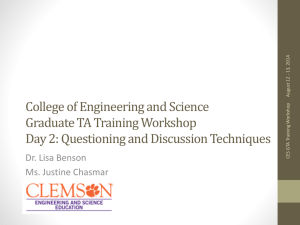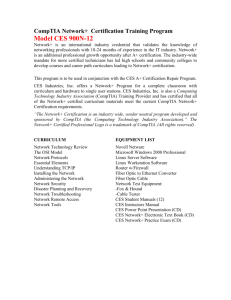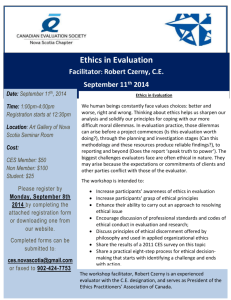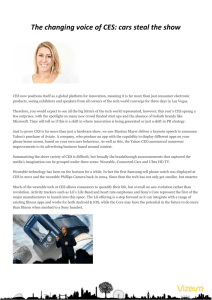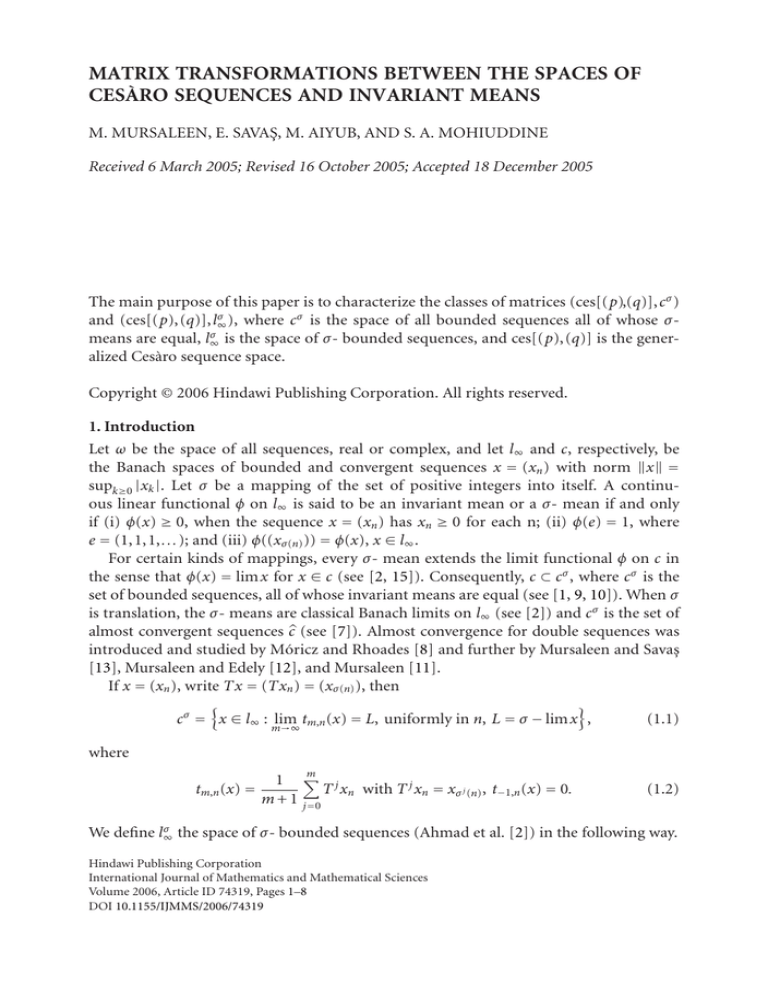
MATRIX TRANSFORMATIONS BETWEEN THE SPACES OF
CESÀRO SEQUENCES AND INVARIANT MEANS
M. MURSALEEN, E. SAVA޸, M. AIYUB, AND S. A. MOHIUDDINE
Received 6 March 2005; Revised 16 October 2005; Accepted 18 December 2005
The main purpose of this paper is to characterize the classes of matrices (ces[(p),(q)],cσ )
σ ), where cσ is the space of all bounded sequences all of whose σand (ces[(p),(q)],l∞
σ
means are equal, l∞ is the space of σ- bounded sequences, and ces[(p),(q)] is the generalized Cesàro sequence space.
Copyright © 2006 Hindawi Publishing Corporation. All rights reserved.
1. Introduction
Let ω be the space of all sequences, real or complex, and let l∞ and c, respectively, be
the Banach spaces of bounded and convergent sequences x = (xn ) with norm x =
supk≥0 |xk |. Let σ be a mapping of the set of positive integers into itself. A continuous linear functional φ on l∞ is said to be an invariant mean or a σ- mean if and only
if (i) φ(x) ≥ 0, when the sequence x = (xn ) has xn ≥ 0 for each n; (ii) φ(e) = 1, where
e = (1,1,1,...); and (iii) φ((xσ(n) )) = φ(x), x ∈ l∞ .
For certain kinds of mappings, every σ- mean extends the limit functional φ on c in
the sense that φ(x) = limx for x ∈ c (see [2, 15]). Consequently, c ⊂ cσ , where cσ is the
set of bounded sequences, all of whose invariant means are equal (see [1, 9, 10]). When σ
is translation, the σ- means are classical Banach limits on l∞ (see [2]) and cσ is the set of
almost convergent sequences c (see [7]). Almost convergence for double sequences was
introduced and studied by Móricz and Rhoades [8] and further by Mursaleen and Savaş
[13], Mursaleen and Edely [12], and Mursaleen [11].
If x = (xn ), write Tx = (Txn ) = (xσ(n) ), then
cσ = x ∈ l∞ : lim tm,n (x) = L, uniformly in n, L = σ − limx ,
m→∞
(1.1)
where
m
tm,n (x) =
1 j
T xn with T j xn = xσ j (n) , t−1,n (x) = 0.
m + 1 j =0
(1.2)
σ the space of σ- bounded sequences (Ahmad et al. [2]) in the following way.
We define l∞
Hindawi Publishing Corporation
International Journal of Mathematics and Mathematical Sciences
Volume 2006, Article ID 74319, Pages 1–8
DOI 10.1155/IJMMS/2006/74319
2
Matrix transformations
Let xn = z0 + z1 + z2 + · · · + zn and
σ
= z ∈ ω : sup ψm,n (z) < ∞ ,
l∞
(1.3)
m,n
where
ψm,n (z) = tm,n (x) − tm−1,n (x)
hj
m
1
=
j
zi ,
m(m + 1) j =1 i=h +1
(1.4)
h j = σ j (n).
j −1
σ is the set of almost bounded sequences l (see [14]).
If σ(n) = (n + 1), then l∞
∞
Let A = (ank ) be an infinite matrix of complex numbers ank (n,k = 1,2,...) and X, Y
two subsets of ω. We say that the matrix A defines a matrix transformation from X into
Y
if for every sequence x = (xk ) ∈ X the sequence A(x) = (An (x)) ∈ Y , where An (x) =
k ank xk converges for each n. We denote the class of matrix transformations from X
into Y by (X,Y ).
The main purpose of this paper is to characterize the classes (ces[(p),(q)],cσ ) and
σ ) and deduce some known and unknown interesting results as corollaries.
(ces[(p),(q)],l∞
σ ) are due to Khan and Rahman [4].
The classes (ces[(p),(q)],cσ ) and (ces[(p),(q)],l∞
If {qn } is a sequence of positive real numbers, then for p = (pr ) with inf pr > 0, we
define the space ces[(p),(q)] by
ces (p),(q) = x ∈ ω :
∞
r =0
where Q2r = q2r + q2r +1 + · · · + q2r+1 −1 and
r
1 q k x k Q2r r
pr
<∞ ,
(1.5)
denotes a sum over the range 2r ≤ k < 2r+1 .
Remark 1.1. If qn = 1 for all n, then ces[(p),(q)] reduces to ces(p) studied by Lim [6].
Also, if pn = p for all n and qn = 1 for all n, then ces[(p),(q)] reduces to ces p studied by
Lim [5].
For any bounded sequence p, the space ces[(p),(q)] is a paranormed space with the
paranorm given by (see [4])
g(x) =
∞
r =0
if H = supr pr < ∞ and M = max(1,H).
1 q k x k Q2r r
pr 1/M
(1.6)
M. Mursaleen et al. 3
2. Sequence-to-sequence transformations
σ ).
In this section, we characterize the classes (ces[(p),(q)],cσ ) and (ces[(p),(q)],l∞
We write a(n,k) to denote the elements ank of the matrix A, and for all integers n,m ≥
1, we write
Axn + TAxn + · · · + T m Axn
m+1
= t(n,k,m)xk ,
tmn (Ax) =
(2.1)
k
m
where t(n,k,m) = 1/(m + 1) j =0 a(σ j (n),k).
We also define the spaces of σ- convergent series and σ- bounded series, respectively,
as follows:
csσ
= x:
m
i=1
i
1 x j
is convergent uniformly in n, as m −→ ∞ ,
i + 1 j =0 σ (n)
bsσ = x : sup
m
n,m i=1
i
1 x j
<∞ .
i + 1 j =0 σ (n)
(2.2)
If we take σ(n) = n + 1, csσ and bsσ reduce to cs and bs , as defined below:
cs = x :
m
i=1
i
1 x j+n is convergent uniformly in n, as m −→ ∞ ,
i + 1 j =0
bs = x : sup
m
n,m i=1
i
1 x j+n < ∞ .
i + 1 j =0
(2.3)
Now we prove the following theorem.
Theorem 2.1. Let 1 < pr ≤ supr pr < ∞. Then A ∈ (ces[(p),(q)],cσ ) if and only if
(i) there exists an integer E > 1 such that for all n,
U(E) = sup
∞
m r =0
Q2r max
r
tr
t(n,k,m)
qk
E −t r < ∞ ,
(2.4)
where 1/ pr + 1/tr = 1, r = 0,1,2,..., and maxr means maximum over 2r ≤ k < 2r+1 ;
σ
(ii) a(k) = (ank )∞
n=1 ∈ c for each k, that is, limm t(n,k,m) = uk uniformly in n, for each
k.
In this case, σ-limit of Ax is ∞
k =1 u k x k .
Proof
Neccessity. Suppose that A ∈ (ces[(p),(q)],cσ ). Now ∞
k=1 t(n,k,m)xk exists for each m
and n and x ∈ ces[(p),(q)], whence {t(n,k,m)}k ∈ ces∗ [(p),(q)] for each m and n, (see
F. M. Khan and M. A. Khan [3] for Köthe-Toeplitz and continuous duals of ces[(p),(q)]).
4
Matrix transformations
Therefore, it follows that each { fm,n }m defined by
fm,n (x) = tm,n (Ax)
(2.5)
is an element of ces∗ [(p),(q)]. Since ces[(p),(q)] is complete and further for each n,
supm |tm,n (Ax)| < ∞ on ces[(p),(q)]. Now arguing with the uniform boundedness principle, we have condition (i). Since ek ∈ ces[(p),(q)], condition (ii) follows.
Sufficiency. Suppose that the conditions hold. Fix n ∈ N. For every integer s ≥ 1, from (i)
we have
s r =0
tr
Q2r max qk−1 t(n,k,m)
r
E−tr ≤ sup
∞ tr
Q2r max(qk−1 t(n,k,m)
r
m r =0
E −t r .
(2.6)
Now letting s → ∞, we obtain
limm→∞
∞ r =0
tr
Q2r max(qk−1 t(n,k,m)
r
E−tr ≤ sup
∞ m r =0
tr
Q2r max qk−1 t(n,k,m)
r
E −t r .
(2.7)
Therefore, from (ii) we have
∞ r =0
tr
Q2r max qk−1 uk r
E−tr ≤ sup
∞ m r =0
tr
Q2r max qk−1 t(n,k,m))
r
E −t r < ∞ .
(2.8)
Hence
(uk )k and {t(n,k,m)}k ∈ ces∗ [(p),(q)], therefore the series ∞
k=1 t(n,k,m)xk and
∞
k=1 uk xk converge for each m and n and x ∈ ces[(p),(q)]. For given > 0 and x ∈
ces[(p),(q)], choose s such that
∞
r =s+1
pr 1/M
1 q k x k Q2r r
< .
(2.9)
∀m > m0 .
(2.10)
Since (ii) holds, there exists m0 such that
s
t(n,k,m) − uk <
k =1
Since (i) holds, it follows that
∞
t(n,k,m) − uk is arbitrary small.
k=s+1
(2.11)
M. Mursaleen et al. 5
Therefore,
lim
m
∞
t(n,k,m)xk =
k =1
∞
uk x k ,
uniformly in n.
(2.12)
k =1
This completes the proof.
Remark 2.1. For different choices of p, q, and σ, we can deduce many corollaries from
the above theorem to characterize the matrix classes, for example, (ces(p),cσ ), (ces p ,cσ ),
(ces p (q),cσ ), (ces[(p),(q)], c), and so forth. The class (ces(p), c) was characterized by F.
M. Khan and M. A. Khan [3] which we can obtain directly from our theorem by taking
qn = 1 for all n and σ(n) = n + 1.
We write (see [2])
x0 = z0 + z1 + · · · + zn ,
ψm,n (Az) =
(2.13)
α(n,k,m)zk ,
k
where
m
1
j
α(n,k,m) =
m(m + 1) j =1
hj
aik ,
h j = σ j (n).
(2.14)
i=h j −1 +1
Now we prove the following theorem.
σ ) if and only if
Theorem 2.2. Let 1 < pr ≤ supr pr < ∞. Then A ∈ (ces[(p),(q)],l∞
sup
∞ m,n r =0
tr
Q2r max qk−1 α(n,k,m)
r
E −t r < ∞ ,
(2.15)
where E is an integer greater than 1 and 1/ pr + 1/tr = 1, r = 0,1,2,....
Proof
∞
σ ). Now
Necessity. Suppose that A ∈ (ces[(p),(q)],l∞
k=1 α(n,k,m)zk exists for each m
∗
and n and z ∈ ces[(p),(q)], whence {α(n,k,m)}k ∈ ces [(p),(q)] for each m and n. Therefore, it follows that { fm,n } defined by
fm,n (x) = ψm,n (Az)
(2.16)
is an element of ces∗ [(p),(q)]. Since ces[(p),(q)] is complete and further supm,n |ψm,n(Az)|
< ∞ on ces[(p),(q)], so by arguing with uniform boundedness principle, we have the
condition.
6
Matrix transformations
Sufficiency. Suppose that condition (2.15) holds. Fix n ∈ N. For every integer s ≥ 1 we
have
s r =0
tr
Q2r max qk−1 α(n,k,m)
r
E−tr ≤ sup
∞ tr
Q2r max qk−1 α(n,k,m)
r
m,n r =0
E −t r .
(2.17)
So
lim
s→∞
s r =0
tr
Q2r max qk−1 α(n,k,m)
r
≤ sup
∞ E −t r
(2.18)
tr
Q2r max qk−1 α(n,k,m) E−tr < ∞.
r
m,n r =0
Hence {α(n,k,m)} ∈ ces∗ [(p),(q)]. Therefore, the series
each m and n and z ∈ ces[(p),(q)].
This completes the proof.
∞
k=1 α(n,k,m)zk
converges for
Remark 2.2. The matrix class (ces(p), l
∞ ), was characterized by F. M. Khan and M. A.
Khan [3] which we can obtain directly from the above theorem by letting qn = 1 for all n
and σ(n) = n + 1. Besides, we can further deduce many corollaries for different choices of
p, q, and σ.
3. Sequence-to-series transformations
For all integers m,n ≥ 1, we write
∗
(Ax) =
tmn
m
tin (Ax) =
i=1
m
i
1 k i=1
i + 1 j =0
a σ j (n),k xk =
t ∗ (m,n,k)xk ,
(3.1)
k
where
t ∗ (m,n,k) =
m
i
1 i=1
i + 1 j =0
a σ j (n),k .
(3.2)
Theorem 3.1. Let 1 < pr ≤ supr pr < ∞. Then A ∈ (ces[(p),(q)],csσ ) if and only if
(i) there exists an integer E > 1 such that for all n,
U(E) = sup
∞
m r =0
Q2r max
r
tr
t ∗ (n,k,m)
qk
E −t r < ∞ ,
(3.3)
where 1/ pr + 1/tr = 1, r = 0,1,2,..., and maxr means maximum over 2r ≤ k ≤ 2r+1 ;
M. Mursaleen et al. 7
σ
∗
(ii) a(k) = {ank }∞
n=1 ∈ cs for each k, that is, limm t (n,k,m) = uk uniformly in n, for each
k.
In this case, the σ-limit of Ax is ∞
k =1 u k x k .
σ ) if and only if
Theorem 3.2. Let 1 < pr ≤ supr pr < ∞. Then A ∈ (ces[(p),(q)],b∞
sup
∞ m,n r =0
tr
Q2r max qk−1 t ∗ (n,k,m)
r
E −t r < ∞ ,
(3.4)
where E is an integer greater than 1 and 1/ pr + 1/tr = 1, r = 0,1,2,....
Proofs of Theorems 3.1 and 3.2 are similar to those of Theorems 2.1 and 2.2, respectively.
Remark 3.1. If σ is translation, then Theorems 3.1 and 3.2 give the characterization for
the classes (ces[(p),(q)], cs ) and (ces[(p),(q)], bs ). As Remarks 2.1 and 2.2, for different
choices of p, q, and σ, we can deduce many corollaries.
References
[1] Z. U. Ahmad and M. Mursaleen, An application of Banach limits, Proceedings of the American
Mathematical Society 103 (1988), no. 1, 244–246.
[2] Z. U. Ahmad, M. Mursaleen, and Q. A. Khan, Invariant means and some matrix transformations,
Southeast Asian Bulletin of Mathematics 23 (1999), no. 4, 533–539.
[3] F. M. Khan and M. A. Khan, Matrix transformation on certain sequence spaces, Tamkang Journal
of Mathematics 19 (1988), no. 4, 25–30.
[4] F. M. Khan and M. F. Rahman, Infinite matrices and Cesàro sequence spaces, Analysis Mathematica 23 (1997), no. 1, 3–11.
[5] K. P. Lim, Matrix transformation in the Cesàro sequence spaces, Kyungpook Mathematical Journal
14 (1994), no. 2, 221–227.
, Matrix transformation on certain sequence spaces, Tamkang Journal of Mathematics 8
[6]
(1997), no. 2, 213–220.
[7] G. G. Lorentz, A contribution to the theory of divergent sequences, Acta Mathematica 80 (1948),
167–190.
[8] F. Móricz and B. E. Rhoades, Almost convergence of double sequences and strong regularity of
summability matrices, Mathematical Proceedings of the Cambridge Philosophical Society 104
(1988), no. 2, 283–294.
[9] M. Mursaleen, Matrix transformations between some new sequence spaces, Houston Journal of
Mathematics 9 (1983), no. 4, 505–509.
, On some new invariant matrix methods of summability, The Quarterly Journal of Math[10]
ematics. Oxford. Second Series 34 (1983), no. 133, 77–86.
, Almost strongly regular matrices and a core theorem for double sequences, Journal of
[11]
Mathematical Analysis and Applications 293 (2004), no. 2, 523–531.
[12] M. Mursaleen and O. H. H. Edely, Almost convergence and a core theorem for double sequences,
Journal of Mathematical Analysis and Applications 293 (2004), no. 2, 532–540.
[13] M. Mursaleen and E. Savaş, Almost regular matrices for double sequences, Studia Scientiarum
Mathematicarum Hungarica 40 (2003), no. 1-2, 205–212.
[14] S. Nanda, Some sequence spaces and almost boundedness, Matematički Vesnik 13(28) (1976),
no. 2, 179–186.
8
Matrix transformations
[15] R. A. Raimi, Invariant means and invariant matrix methods of summability, Duke Mathematical
Journal 30 (1963), no. 1, 81–94.
M. Mursaleen: Department of Mathematics, Faculty of Science, King Abdul-Aziz University,
P.O. Box 80203, Jeddah, The Kingdom of Saudi Arabia
E-mail address: mursaleen@math.com
E. Savaş: Department of Mathematics, Y. Y. University, 65080 Van, Turkey
E-mail address: ekremsavas@yahoo.com
M. Aiyub: Department of Mathematics, Aligarh Muslim University (AMU),
Aligarh 202002, India
E-mail address: mohdaiyub@rediffmail.com
S. A. Mohiuddine: Department of Mathematics, Aligarh Muslim University (AMU),
Aligarh 202002, India
E-mail address: mohiuddine@math.com



